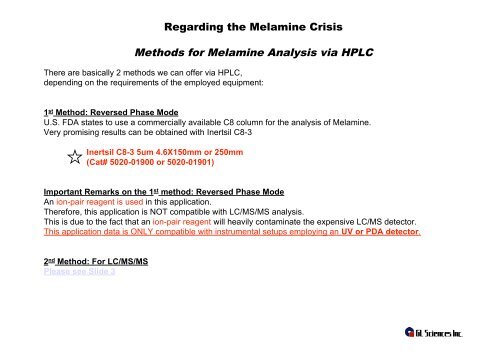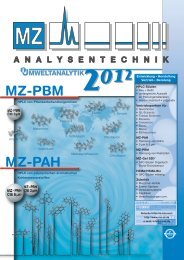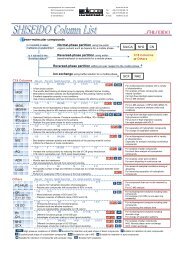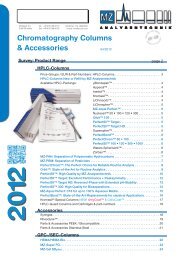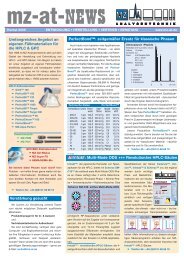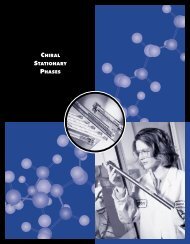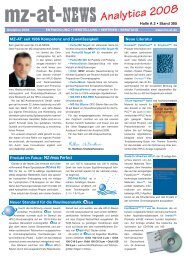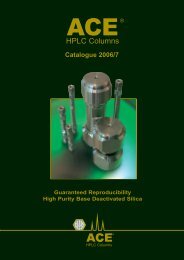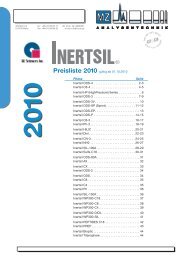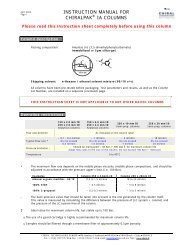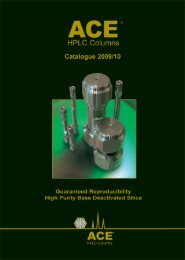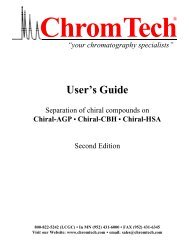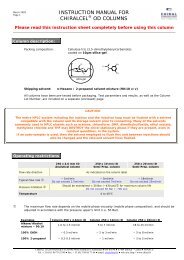Preparation of a standard Melamine solution
Preparation of a standard Melamine solution
Preparation of a standard Melamine solution
You also want an ePaper? Increase the reach of your titles
YUMPU automatically turns print PDFs into web optimized ePapers that Google loves.
Regarding the <strong>Melamine</strong> Crisis<br />
Methods for <strong>Melamine</strong> Analysis via HPLC<br />
There are basically 2 methods we can <strong>of</strong>fer via HPLC,<br />
depending on the requirements <strong>of</strong> the employed equipment:<br />
1 st Method: Reversed Phase Mode<br />
U.S. FDA states to use a commercially available C8 column for the analysis <strong>of</strong> <strong>Melamine</strong>.<br />
Very promising results can be obtained with Inertsil C8-3<br />
Inertsil C8-3 5um 4.6X150mm or 250mm<br />
(Cat# 5020-01900 or 5020-01901)<br />
Important Remarks on the 1 st method: Reversed Phase Mode<br />
An ion-pair reagent is used in this application.<br />
Therefore, this application is NOT compatible with LC/MS/MS analysis.<br />
This is due to the fact that an ion-pair reagent will heavily contaminate the expensive LC/MS detector.<br />
This application data is ONLY compatible with instrumental setups employing an UV or PDA detector.<br />
2 nd Method: For LC/MS/MS<br />
Please see Slide 3
Regarding the <strong>Melamine</strong> Crisis<br />
1st Method: Reversed Phase Mode, Inertsil C8-3 5um 4.6X150mm
Regarding the <strong>Melamine</strong> Crisis<br />
1st Method: Reversed Phase Mode, Inertsil C8-3 5um 4.6X250mm
Regarding the <strong>Melamine</strong> Crisis<br />
LC/MS/MS-Method<br />
2 nd Method: For LC/MS/MS<br />
If you will be using a LC/MS/MS, please use the following:<br />
Inertsil HILIC 5um 3.0X150mm on LC/MS/MS-System<br />
(Cat# 5020-07715)<br />
Important Remarks on the 2 nd method: For LC/MS/MS<br />
The mobile phase used in this application data is compatible with LC/MS/MS.
4<br />
Regarding the <strong>Melamine</strong> Crisis<br />
2 nd Method: For LC/MS/MS, Inertsil HILIC 5um 3.0X150mm
5<br />
Regarding the <strong>Melamine</strong> Crisis<br />
2 nd Method: For LC/MS/MS, Inertsil HILIC 5um 3.0X150mm
6<br />
Regarding the <strong>Melamine</strong> Crisis<br />
2 nd Method: For LC/MS/MS, Inertsil HILIC 5um 3.0X150mm
7<br />
Regarding the <strong>Melamine</strong> Crisis<br />
2 nd Method: For LC/MS/MS, Inertsil HILIC 5um 3.0X150mm
8<br />
Regarding the <strong>Melamine</strong> Crisis<br />
2 nd Method: For LC/MS/MS, Inertsil HILIC 5um 3.0X150mm
9<br />
Regarding the <strong>Melamine</strong> Crisis<br />
2 nd Method: For LC/MS/MS, Inertsil HILIC 5um 3.0X150mm
10<br />
Regarding the <strong>Melamine</strong> Crisis<br />
2 nd Method: For LC/MS/MS, Inertsil HILIC 5um 3.0X150mm
11<br />
Regarding the <strong>Melamine</strong> Crisis<br />
2 nd Method: For LC/MS/MS, Inertsil HILIC 5um 3.0X150mm
12<br />
Regarding the <strong>Melamine</strong> Crisis<br />
<strong>Preparation</strong> <strong>of</strong> a <strong>standard</strong> <strong>Melamine</strong> <strong>solution</strong><br />
Background information <strong>of</strong> <strong>Melamine</strong> (2, 4, 6-triamine-s-triazine)<br />
It is only slightly soluble in water.<br />
It is soluble to warm (hot) water and diluted hydrochloric acid.<br />
However, it is insoluble in hydrophobic solvents.<br />
<strong>Preparation</strong> <strong>of</strong> <strong>standard</strong> stock <strong>solution</strong> <strong>of</strong> <strong>Melamine</strong><br />
1) Measure 50mg <strong>of</strong> <strong>Melamine</strong>.<br />
2) Dissolve it by 20% Methanol <strong>solution</strong> and making it at 50mL.<br />
3) Use this <strong>solution</strong> as a 1,000ppm <strong>standard</strong> stock <strong>solution</strong>.<br />
<strong>Preparation</strong> <strong>of</strong> <strong>standard</strong> <strong>Melamine</strong> <strong>solution</strong><br />
1) Whenever using the above <strong>standard</strong> stock <strong>solution</strong>, always add 1% trichloroacetic acid and dilute it.<br />
2) Then use the <strong>solution</strong> as a <strong>standard</strong> <strong>Melamine</strong> <strong>solution</strong>.<br />
For example:<br />
1) Take 1mL <strong>of</strong> the <strong>standard</strong> stock <strong>solution</strong> and add 1% trichloroacetic acid and make it at 10mL.<br />
2) This 10mL will be the <strong>standard</strong> <strong>Melamine</strong> <strong>solution</strong>.<br />
3) In this case, 0.1mg <strong>of</strong> <strong>Melamine</strong> will be contained in a 1mL <strong>of</strong> <strong>standard</strong> <strong>Melamine</strong> <strong>solution</strong>.
13<br />
Regarding the <strong>Melamine</strong> Crisis<br />
Procedure <strong>of</strong> Sample <strong>Preparation</strong>
14<br />
Regarding the <strong>Melamine</strong> Crisis<br />
Solid Phase Extraction Method
15<br />
Regarding the <strong>Melamine</strong> Crisis<br />
Ordering Information<br />
* For price information, please send a quotation request:<br />
Info@mz-at.de?subject=melamin-analytics


